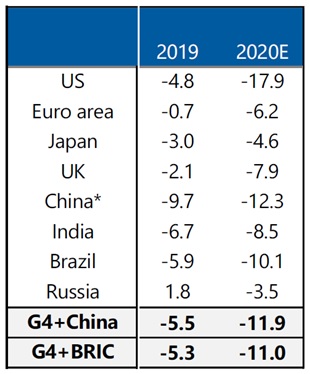We’ve been concentrating on the fiscal and monetary response to the coronavirus pandemic. The responses are similar to the playbook developed in the wake of the Great Recession, but in scope and size, they are unprecedented.
Our coverage has been primarily of the response of U.S. authorities so far. This week we will broaden the focus a little to provide in addition a summary of significant actions taken by the world’s other governments and financial authorities. The Fed has done a lot of the heavy lifting, which was perhaps unavoidable given the dollar-centric nature of the global financial system — something which is a boon to the U.S. in many respects, but can create the risk of severe systemic problems in a crisis. We’ll discuss this further in future letters. Still, the Fed has not acted alone; virtually all the world’s governments and central banks are participating in the effort.
Here are the measures taken by the most important of the developed world’s central banks:
- a total of $4.5 trillion USD in balance sheet expansion is currently expected.
- $1.7 trillion USD: €120 billion already announced, the €750 Pandemic Emergency Purchase Program (PEPP), and the normal asset purchase program of €20 billion/month. An additional €250 billion is expected for the PEPP this fall.
- $300 billion USD: “About ¥28 trillion of QE by March 2021and special funds-supplying operations for corporate financing of about ¥3.4 trillion.
- $730 billion USD: “£200 billion in QE already announced, with the Term Funding Scheme (TFS) calibrated to allow for a demand-driven £200bn new lending, and an expected £20 billion via the Covid Corporate Financing Facility (CCFF). An additional £60bn QE is expected in the fall.
Taken together, the G4’s central banks are providing $7.2 trillion. China and India also announced smaller measures.
Fiscal Measures Worldwide
The fiscal deficit in the U.S., after the recent CARES Act, is already at 18% of GDP. A further $1.25 trillion stimulus bill would raise that to 24% of GDP.
As a percentage of GDP, the “G4+China” cyclically adjusted primary deficit will reach 9.2% of GDP in 2020, significantly higher than the 6.5% reached in 2009 in the wake of the Great Financial Crisis.
Here is a comparison between budget deficits this year and last, across major economies:

Source: Morgan Stanley Research
Fiscal measures in most countries include:
- direct support of the medical system,
- tax relief for individuals and businesses,
- and subsidized loans and grants to businesses, and
- expansion of welfare benefits to citizens, including extended unemployment benefits as well as direct cash transfers.
Market Summary
We continue to watch markets rebound from their March lows. The consensus of market observers still holds that a correction towards those lows is likely as companies make their quarterly earnings calls, describe the economic effects of the pandemic, and try to chart the course for the coming quarters in the face of uncertainty about the timeframe for economies to reopen. There will also be further poor economic data to come on sharply contracting growth, unemployment, and bankruptcies.
Still, many are beginning to believe that this corrective “retest” will be shallower than feared, given the size and scope of support described above. We recommend that readers continue to prepare their buy lists, and be willing to tolerate a certain amount of volatility for the sake of establishing positions at prices that in hindsight may prove to be unreasonably low. Some companies and industries in areas obviously benefitted by the changes afoot in the world have seen their stocks move ahead dramatically — some biopharma companies, for example, and companies related to e-commerce and remote work flow. Others that have not garnered much public attention have languished.
Our attention is particularly focused on growth companies with enduring thematic relevance, strong revenue growth, good management, and innovative research and development pipelines, particularly in technology and healthcare. Post-COVID, we believe technological, social, and economic trends supporting such companies will accelerate.
We are also attentive to dividend-yielding companies employing reasonable amounts of financial leverage, with sustainable dividends, whose share prices were decimated by the fear of a COVID-created financial collapse — an event that we believe Federal Reserve action has made very unlikely.
As we have said before, although the world is currently in the grip of powerful deflationary forces, the world’s fiscal response is very likely to generate inflation in coming years. Gold could do well this year, in spite of the specter of deflation, and we are quite confident that it will do well if and when inflationary forces seize the upper hand in the economic tug-of-war.
We look forward to hearing that you are staying safe and healthy, and taking good care of yourself and your loved ones.
Thanks for listening; as always, we welcome your calls and questions.

